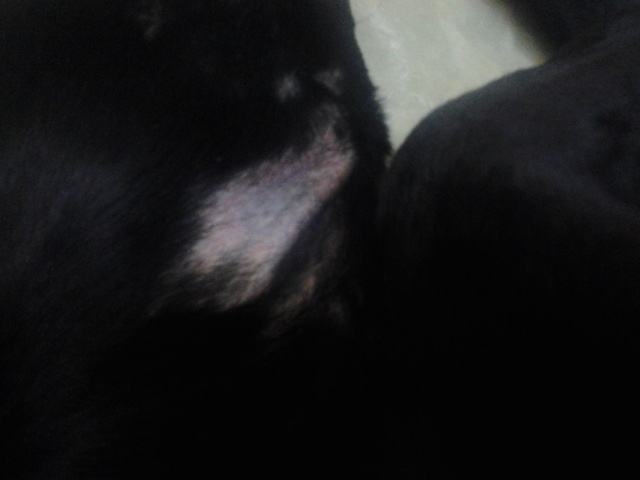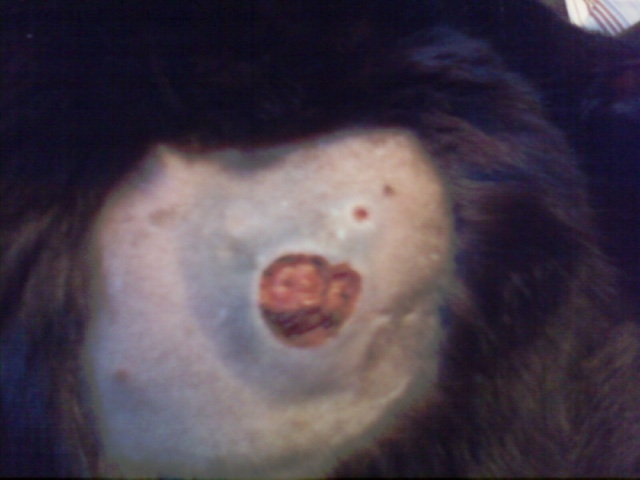QuestionI need some help. I'm having a problem with Lady dog - golden retriever - age 8 years. She is dripping clear, odorless liquid. Sometimes it is just drips and other times it is fairly large puddles. Please advise -- thanks a million. Gene
AnswerHi Gene!
It is normal for dogs and cats to have a slight discharge at certain times, such as when they are in heat. Most of the time, however, a genital discharge is a sure sign of infection, and you will need to take care of it right away.
Female dogs and cats are much more likely than males to have a genital discharge. Female pets that haven't been spayed will sometimes get a serious uterine infection called pyometra. This can result in a bloody, pus-filled discharge. It commonly occurs about 45 to 60 days after the pet was in heat and wasn't bred.
Discharges will sometimes occur in pregnant dogs and cats when they are about to have a miscarriage. This is nature's way of taking care of abnormal fetuses or an infection in the womb that would otherwise threaten the mother's life. This type of discharge will usually be bloody, possibly with a little pus mixed in.
Females that have recently had a litter are also prone to uterine infections. What sometimes happens is that part of the placenta stays behind after delivery, providing a fertile breeding ground for bacteria.
You should suspect that something is wrong if the new mother, who is generally overprotective, ignores her offspring or refuses to eat. This type of infection usually causes a foul-smelling vaginal discharge that starts out watery and a little red, and then gets thicker and turns dark brown and contains pus as the infection progresses.
It doesn't happen often, but an infection and discharge may occur after dogs and cats are spayed if a little bit of the uterus was left behind. If your pet is listless, lacks an appetite, drinks a lot of water, and is paying a lot of attention to her backside -- such as excessive licking -- check under her tail for a discharge. If you see a discharge, take her back to the vet immediately, he advises.
See Your Vet If...
The discharge is bloody or has a foul odor
Your dog or cat has a fever or diminished appetite
Your pet is spending a lot of time licking the backside
Your pet's tail is limp
A discharge from the anus, penis, or vagina has lasted two days or more
Your pet is constantly licking his back end
The vagina or anal area is red and swollen
There is a growth on the anus or genitals
Urine is dribbling while your pet sleeps
There has been a change in your pet's urinating habits, or he is unable to urinate
There is blood in the urine
He's lost fur on the top or base of the tail
The tail is greasy or infected, or it is getting thicker
The anal opening stays open
Your pet has been scooting for two days or more
By the time a genital discharge appears, the underlying infection is probably well-advanced and needs quick treatment. These infections can be life-threatening, so get your pet to the vet as soon as possible. In males, it is a good idea to apply an ice pack to the penis until you can get him to the vet. This will help reduce swelling that can be caused by a prostate infection.
Even though you can't treat internal infections at home, they are often easy to prevent. Having your pet neutered will guard against almost all the problems that can cause a genital discharge in males as well as females.
Uterine infections are serious because there is a chance that the infection will spread to other parts of the body. Your vet will probably keep a pet with a uterine infection at the hospital and give her intravenous antibiotics.
Infections in males are generally less serious. Your vet will probably give you a prescription for oral antibiotics, which will clear up the condition in a week or two. For problems with the prostate gland, the simplest solution is to neuter your pet. During the procedure the prostate gland -- as well as the testicles -- are removed.
A few common causes of hindquarter conditions are blocked or infected anal sacs, herniated disk, kidney failure, perianal fistula, prostate problems, tapeworms, urinary stones, urinary tract infections and uterine infection. Learn more about these common conditions now.
Blocked or infected anal sacs
Dogs and cats depend on their sense of smell to identify territory and recognize other pets. Unlike humans, who may introduce themselves by handing out calling cards, dogs and cats say "Hi" by releasing a strong-smelling liquid from the anal sacs -- two small pouches on either side of the anus. When other pets smell this liquid, either on the ground or by sniffing rear ends, they are able to tell who they are talking to.
The openings to the anal sacs are quite small. They often get impacted, which prevents fluids from draining. Pets with blocked anal glands get very itchy and sore. They may develop infections as well.
Once the fluid accumulates, your pet will have a sore backside. To relieve the discomfort, dogs and cats will often lick their behinds or scoot them along the ground.
Anal sac problems are very common and, in most cases, easy to treat. Veterinarians can usually unblock the openings and ease the pressure simply by pressing on the glands. If there is an infection, your pet will probably need antibiotics as well.
Herniated disk
Dogs and cats walk on all fours, so they don't do a lot of bending, which is why spinal problems in pets are quite rare. As they get older, however, the protective cushions between the vertebrae, called spinal disks, will occasionally weaken. (This is particularly common in dachshunds because their long bodies puts additional stress on the disks.) If a disk breaks or ruptures, the material inside will ooze out, possibly putting pressure on a spinal nerve. This condition, called a herniated disk, may cause dogs and cats to lose control of their bowels or bladder, or to have an unstiff tail or a limp. If there is enough pressure on their spinal cords, pets may become paralyzed.
A herniated spinal disk is potentially serious and should always be treated by a vet right away -- especially if your pet is in a lot of pain or is reluctant to move. Most of the time, however, keeping dogs and cats confined, such as in a crate, for two weeks will allow the disk to heal on its own. If it doesn't get better, your pet may need surgery to remove it. Removing the disk will relieve pressure on the spinal nerves, and the symptoms will start to improve right away.
Kidney failure
The kidneys are responsible for filtering wastes from your pet's body and eliminating them in the urine. When the kidneys aren't working properly as a result of infections, for example, wastes begin to accumulate, often rising to dangerous levels. Kidney disease is an emergency that always requires quick attention.
There are several warning signs when the kidneys aren't working the way they should. Your pet's urine is normally yellow or amber. If it suddenly turns clear, it could mean that the kidneys have stopped filtering wastes. Over time, pets with kidney disease will start producing less and less urine, which means that the kidneys have essentially shut down.
Because kidney disease is so serious, it is critical to call your vet as soon as you notice any change in your pet's urine or urinating habits.
Perianal fistula
The tissues of the anus and rectum are very fragile. When they get inflamed and irritated because of an infected hair follicle, for example, or because mucus-producing glands have become blocked by stool, they can break down and bleed, forming painful sores. These sores, called perianal fistulas, can make having a bowel movement extremely painful and may cause a foul-smelling discharge as well. They are most common in German shepherds, Irish setters, and other large dogs.
Dogs with perianal fistulas will often need antibiotics to treat and prevent dangerous infections. In addition, surgery is usually needed to remove damaged tissue and to "rearrange" your pet's anatomy so that the area drains better in the future.
Tapeworms
They are extremely creepy, but tapeworms usually aren't a serious problem. Most dogs and cats will get them at some time in their lives -- often from eating birds, mice, or other rodents, or from swallowing infected fleas. Tapeworms spend their entire lives in the digestive tract. You only discover them because they periodically shed small segments of their bodies, which look like bits of white rice and appear in the stool or around the anus.
Tapeworms will occasionally cause fever or fatigue. More often, the main symptom is itching, which occurs when tapeworm fragments irritate the anal area. Dogs and cats with tapeworms will often scoot their bottoms on the ground or spend a lot of time licking their backsides.
Tapeworms are very easy to treat with medications that you can get from your vet or pet supply stores. The problem is that the worms often come back; most people will treat their pets for tapeworms more than a few times. One of the best ways to prevent tapeworms is to go after the fleas that often cause them. When you control the flea population, you will automatically reduce the risk for tapeworms.
Urinary stones
The urine looks like it is all liquid, but it actually consists of dissolved chemicals, minerals, and other wastes. Most of the time, these wastes stay in a liquid form. In some dogs and cats, however, the minerals will bond together to form hard little stones, usually the size of fine gravel but sometimes as big as a pea. As you would expect, passing these stones in the urine can be extraordinarily painful. Pets with stones will often cry when they urinate, and there may be blood in the urine as well.
Urinary stones are more of a problem for male pets simply because the tubes in their urinary tracts are narrower than in females. The usual treatment is to give pets medications to make their urine more acidic, which helps prevent stones from forming. In addition, many pets will be put on special diets so that they get less of the stone-causing minerals in their systems. When the stones are large, however, the only solution may be surgery to remove them.
Pets that have had one attack of urinary stones will invariably get another. To reduce the risk, vets recommend giving pets plenty of water. This helps dilute the urine, making it harder for stones to form.
Urinary tract infections
Bacteria can make themselves at home anywhere in the urinary tract -- in the bladder, kidneys, or urethra (the tube through which urine flows). Most of the time, these bacteria don't cause problems. But when they multiply to large enough numbers, they can cause painful infections. Pets with urinary tract infections will often urinate more often than usual because the lining in their urinary tracts is sore and irritated. There may be blood in the urine as well.
Most urinary tract infections aren't too serious, although they always need prompt treatment to prevent the infection from getting worse. Your vet will probably give your pet oral antibiotics, which will relieve the infection in a week or two. Your vet will also recommend that you encourage your pet to drink water as often as possible. Getting more fluids will help wash bacteria out of the urinary tract before they are able to cause an infection.
Uterine infection
Dogs and cats get mild infections all the time, and their immune systems usually clear things up even before you notice that there is a problem. Not so with uterine infections. Pets with this condition -- usually new mothers or pets that are pregnant -- can get extremely sick very quickly. There may be a strong-smelling, pus-filled, or bloody discharge. Your pet will probably have a fever as well, and she won't feel like eating or exercising. Uterine infections are always an emergency. Call your vet immediately if you even suspect that this could be the problem.
I hope this has been helpful and I wish you the best of luck!Please keep me posted and give that Golden Retriever millions of kisses for me!Sending wagging tails your way!
Nicole

 UPDATE: 13 Year old Siamese - not eating
QuestionQUESTION: During his annual check-up 2 months a
UPDATE: 13 Year old Siamese - not eating
QuestionQUESTION: During his annual check-up 2 months a
 Guinea Pig Eyes
Question
Bad Eye
Hello, yesterday we purchased a
Guinea Pig Eyes
Question
Bad Eye
Hello, yesterday we purchased a
 Radioiodine treatment of hyperthyroidism in our cat
Question
Molly
Dear Jana,
I wrote you near the end of
Radioiodine treatment of hyperthyroidism in our cat
Question
Molly
Dear Jana,
I wrote you near the end of
 My 5 month old Labrador blad spot
QuestionBald spot on neck
Bald spot on leg
My 5 month old Labrador blad spot
QuestionBald spot on neck
Bald spot on leg
 Blue Skin Around Abscess
Question
Kittys Wound
A few weeks ago we noticed
Blue Skin Around Abscess
Question
Kittys Wound
A few weeks ago we noticed